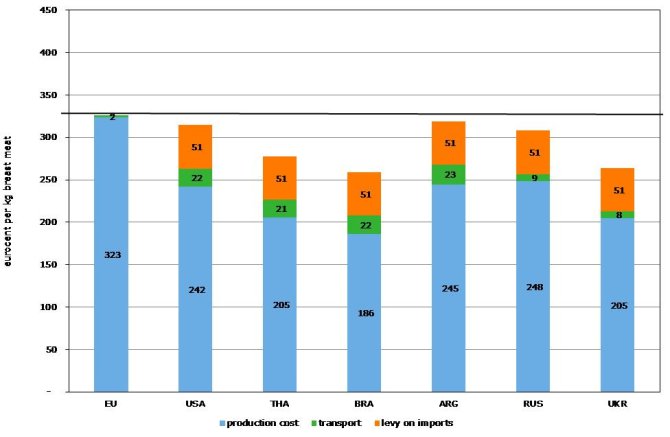
News
Reduction import levies damages the competitive position of the European poultry meat sector
Despite the current import levy on chicken breast fillet, Brazil and Ukraine are competitive at the EU market. The offer price of breast fillet in 2017 of Brazil and Ukraine was almost equal to the average EU price. In a scenario with 50% lower import levies and 10% lower exchange rate all countries in the study (Brazil, Ukraine, Thailand and the USA, Argentina and Russia) have a lower offer price for breast fillet compared to the EU poultry meat industry. The report of Wageningen Economic Research examining how lowering import levies impacts the competitiveness of the EU poultry industry shows this.

Figure: Offer price of breast fillet in Germany from EU average (horizontal line) and non-EU countries in eurocents per kilogram with 50% lower import levy and 10% lower exchange rate
EU poultry meat producers must comply with legislation on environmental protection, animal welfare and food safety. The additional costs of EU legislation on farm level were estimated to be 6.1% of the total production costs at farm level in 2017.
The EU is an important player in the international trade of poultry meat. In 2017, the EU exported 1.662 million tonnes of poultry meat with a value of €1.988 billion while it imported 0.806 million tonnes with a value of €2.015 billion.
Import levies protect the EU poultry meat sector from large volumes of imports from thirds countries. If multilateral or bilateral negotiations with non-EU countries result in reducing import levies more imports can be expected. This is illustrated in the report. In the scenario of the combined consequences of a 50% lower levy on imports and 10% lower exchange rates, all third countries obtain a competitive to strongly competitive position in the EU market for breast fillet.
Compared to the results of the 2015 base line the production costs of poultry meat decreased in the EU countries. Also, in Thailand and the USA production costs decreased. Production costs in Brazil and Ukraine slightly increased between 2015 and 2017. This was a result of changes in feed prices and exchange rate of currency of these countries to the euro. The result was a small improvement in competitiveness of the EU compared to the competitor Brazil and Ukraine.